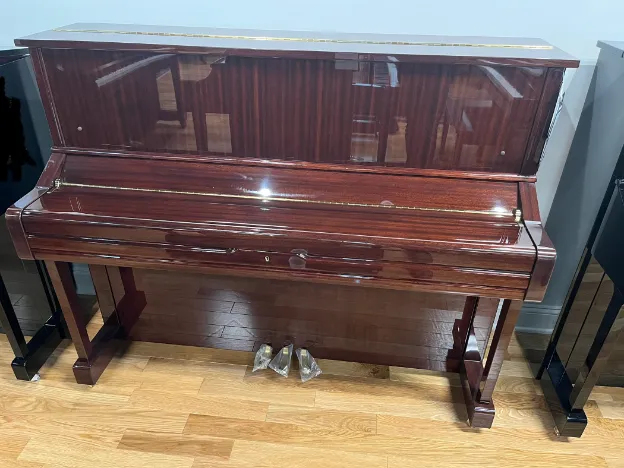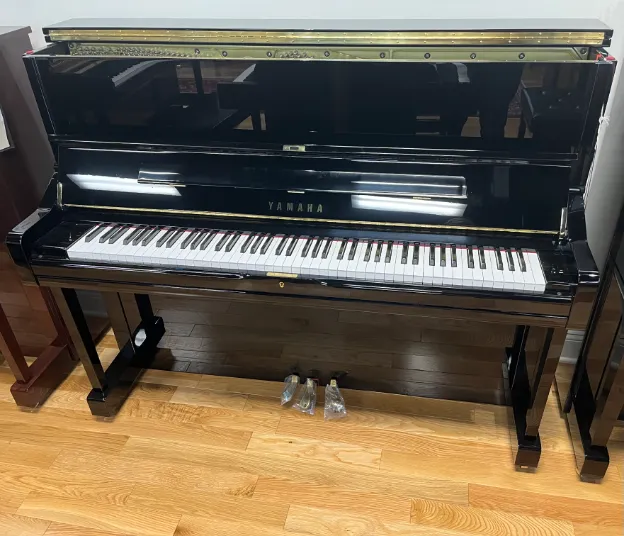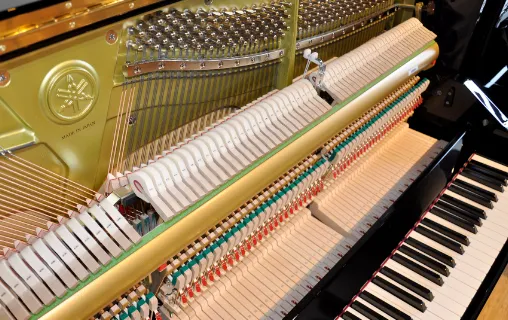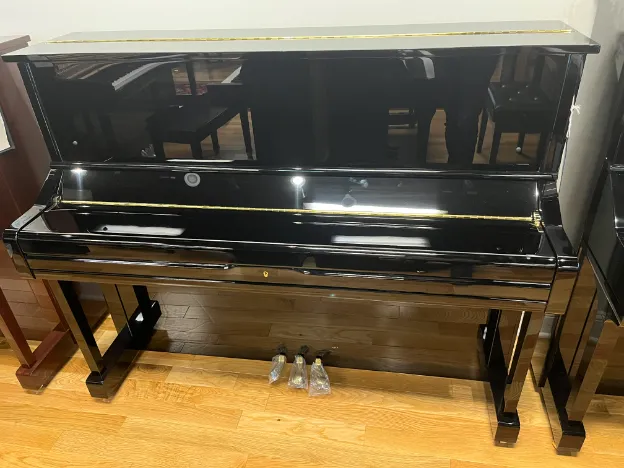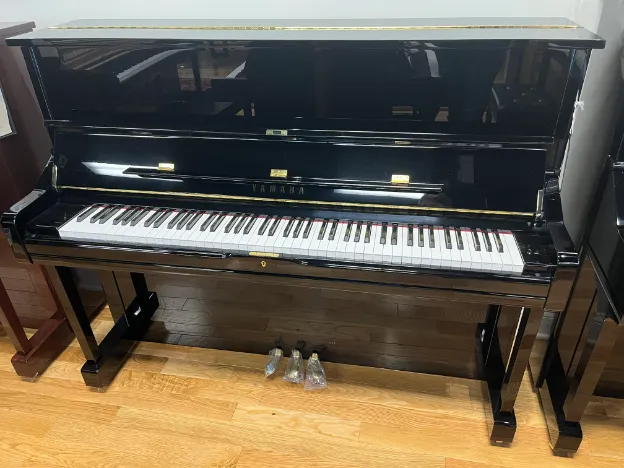Yamaha U1 Upright Piano Review from a Piano Tuner
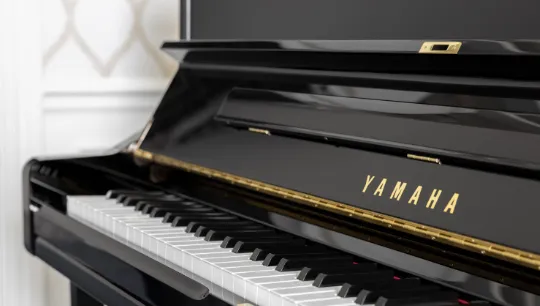
Yamaha U1 Piano Review
In the world of pianos, one simply cannot ignore Yamaha.
As for new Yamaha Upright pianos, there are the U series, B series and the P22.
Overwhelmingly, technicians prefer the U series over the B series and P22 because the U series has better tuning stability and a better performing action.
As a technician myself, the U series is one of my top choices for an upright because (without getting too costly) it is one of the easiest pianos to work on and tune cleanly in a very short amount of time.
Out of all the professional upright pianos this one is a personal perennial favorite of mine.
Tech details
What are the benefits of a Yamaha U1 acoustic piano?
The features of a Yamaha U1 from a technical perspective:
Easy to tune
No false beats
Tight pinblock
Easy to repair
Parts available if necessary
10 Year Warranty
Few problems, easily fixable
Good price
The Yamaha U1 is slightly easier to tune than the U3 or YUS5 due to how quickly the strings render because it is a slightly smaller piano.
Any action problems in Yamaha U1 generally have to do with bobbling hammers which can easily be addressed by shimming the balance rail and reducing lost motion across the keys by raising the capstans after the felts have compressed over time.
They are unequivocally the most identical pianos on the market, which means that once you've worked with one U1, you've worked with them all.
As for tuning, I would go so far as to say that it is difficult to do a bad tuning on this piano because of how clean the strings sound for the technician to tune up.
For Pianists
Each key of a Yamaha feels exactly the same when prepped properly, while that bass notes may be slightly heavier due to the hammer weight, it is only natural for the keys to feel that way and are completely consistent when regulated properly, which makes them excellent pianos.
The main difference between the U1 and the U3 or YUS5 piano model is what I like to call the overall “depth of sound” compared with these large uprights having a larger soundboard, strings, and thus larger sound and depth. Though, don’t forget that the keys feel a bit different too (think inertia of the key and whether you have a heavy hand or not).
Or, as I like to put it; The sound has more space to develop when pianos become larger.
The solid spruce soundboard is typical for most pianos, but having the extra size compared with the B series or P22 makes for a truly extraordinary sounding pianos.
The soft-close fallboard is a great new feature in current models which were not available in older instruments so as to prevent the loud crashing of a falling key cover and to reduce risk of hand injury.
Professional musicians prefer the U series model because they feel and sound exactly as they expect a piano to feel and sound like.
I know it may sound simple, however, if you are an experienced pianist, it becomes ever more clear to tell if a piano does not feel and sound like the way you think it should.
B series pianos tend to need more tunings and to be entirely honest, I'm not exactly sure why this is the case.
The U series is among the best Yamaha pianos for uprights, if you are comparing pianos within the U series it typically becomes a matter of taste.
What do pianists think of the Yamaha U1?
"So many Universities have them, they’ve become the gold standard for what an upright piano ought to feel like and sound like."
"I was comparing other models and it really gives you the most bang for your buck"
"We had to get a piano that was good enough for lessons"
"A Yamaha U1 is a medium grade upright piano very easy to control, and a pretty decent sound. Definitely one of the greater uprights made."
Robustness
Will a Yamaha U1 last?
Even after years of heavy use, the Yamaha U1 acoustic piano continues to have outstanding tone, tight pins, and great structural stability.
At regular use, it is always recommended that a regulation be done every 5-10 years and a voicing be done as often as necessary.
Whether the piano is a Yamaha Brand or otherwise, it is generally recommended that a tuning be done 2-4 times a year for optimal tuning stability and performance year-round.
Throughout the full range of the instrument it tunes up very cleanly so it makes it even easier for technicians with low experience to do a good job on the piano tuning.
What’s a good price for a Yamaha U1?
Cheat sheet for negotiating price: Piano Buyer Book
Save thousands of dollars with this $20 book.
When you spend slightly more money to go above the B series Yamaha uprights, you will find a major difference in playability, tone quality, and tuning stability in the next tier of Yamaha pianos, which happens to be the U1.
This Yamaha Upright Piano has the best price point of the new U series models available and is the gold standard for upright pianos within the most reasonable price range.
This piano provides great value for the money that you pay, it’s not too inexpensive to where it requires more tunings than usual, so it earns a sweet spot between quality and affordability.
For its price range, the U1 is capable of outstanding musical performance in the upright world and pianists know it.
The B series pianos are great pianos for their price range, but once you get to the least expensive U series pianos (being the U1), you reach the sweet spot for pianos in that price range and quality.
Yes, bigger is better in the piano world, which makes the U1 the best value instrument adjacent to the B series, and is considerably competitive with larger pianos in the U series.
It is my opinion that the Yamaha U1 model upright is truly in the sweet spot of price range and quality.
Product Support
Thankfully, Yamaha does better than a 90-day full-service warranty; it turns out that their warranties are 5 years long!
Service
https://usa.yamaha.com/support/contacts/form.html?page=product
^^^Note: Most messages sent through this product support page are answered within 72 hours
Phone support
(714) 522-9980
Monday - Thursday
8:30am - 12:00 pm & 1:00pm - 5:00pm (PST)
Friday
8:30am - 5:00pm & 1:00pm - 4:00pm (PST)
Order piano parts
How does a U1 compare to the B series?
The Yamaha B series pianos are great pianos for the price range, but inexpensive is not always better.
If you’re not in the market for grand pianos, then having a solid upright is extremely important for piano playing, especially for lessons.
In my opinion, a brand new piano like a Yamaha U1 is a perfect option for those looking for a solid piano.
General Information
The Yamaha U series pianos are extremely competitive with other studio-sized pianos often being referred to as the "favorite."
Grey market Yamahas are actually pianos manufactured by Yamaha that were built for a more humid environment than most of North America; you will not find a brand new grey market piano anymore, this happened many decades ago and is more of a long-standing legend at this point and I do not recommend buying these "grey market" pianos at all.
Yamaha operates in the United States as well as Japan and Indonesia. It is possible to have a Yamaha made in either Japan or Indonesia.
When asked, salespeople should be able to discern which country the piano was made.
There are certain markings and insignia on the piano that show where the piano was made, especially if its from Japan.
